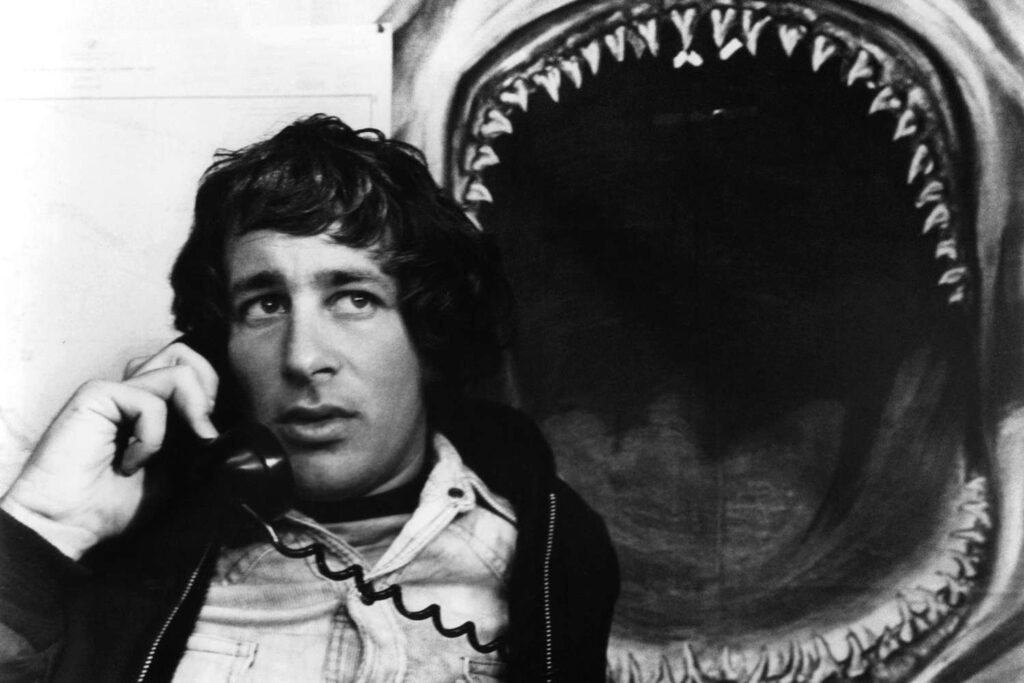“I think I just lost it.”
Phrases like that are repeated by Steven Spielberg in the new National Geographic documentary Jaws @ 50: The Definitive Inside Story. The great director, who pole-vaulted from “promising newcomer” to “visionary behind the biggest moneymaker of all time” with the shark-hunting adventure, is clearly still rattled by the psychological torment of leading the massive, costly, and difficult production at the age of 26.
It’s been long known that Jaws went substantially over budget and went 100 days beyond its original schedule. (Indeed, there has been a Broadway play about this!) But to see the grandfatherly Spielberg, whose work feels infallible today, reflect on it so long after the fact is one of the more striking elements of this extremely watchable documentary.
Diltz/Rue Des Archives/Everett
The problems were many. The studio rushed the film into production, hoping to capitalize on the tremendous book sales. (Spielberg admits, however, this may have been a boon in some respects. The mechanical sharks weren’t ready to shoot the prologue, and this made him realize it may be scarier, in fact, to not see the threat until later in the movie.)
The three enormous fiberglass sharks were technical marvels, but designed for freshwater. No one thought about the implications of shooting in seawater and the negative effects of electrolysis. This made for an endless series of delays, which afforded stars Robert Shaw and Richard Dreyfuss to get on one another’s nerves. (This may have ultimately helped their performances, but made for stress on set.) Shaw was also a heavy drinker, so occasionally there’d be times when finally everything would be working, but he couldn’t nail his dialogue.
Then came the headaches of shooting on water in general. (One time, the boat took on too much water and sank.) As James Cameron, who knows a thing or two about making wet movies, said in the documentary about filming on water, “It doesn’t get twice as hard — it instantly gets five times as hard.”
Sign up for Entertainment Weekly‘s free daily newsletter to get breaking TV news, exclusive first looks, recaps, reviews, interviews with your favorite stars, and more.
Jaws was Spielberg’s first big studio opportunity after working in television and making one small feature, The Sugarland Express. With so much money at stake, Hollywood trades were already speculating if he’d ever work again once he got back from the Martha’s Vineyard location. His advocate at Universal, Sid Sheinberg, even flew across the country to sit him down and say, “This can’t continue.”
The frustrations of the actors, crew, and studio investors were on Spielberg’s shoulders, but he stuck to his guns because he knew what the movie could be if he got the shots that he needed. (He did, as reported in the doc, regularly call his mother and freak out. “Mommy, this is really impossible. Help!” he quoted himself as saying.)
“When the film wrapped Martha’s Vineyard, I had a full-blown panic attack,” he said. “I couldn’t breathe, I thought I was having a heart attack. I couldn’t get a full breath of air. I kept going to the bathroom and splashing water on my face. I was shaking.”
Courtesy Everett
He continued, “It was everything that I had experienced on the island, trying to hold myself together, but hold the crew together. I felt really responsible for keeping them there for as long as we had to stay.”
Even though Jaws was a box office hit and cultural phenomenon in excess of anyone’s dream — making the cover of both Time and MAD magazines — and it set Spielberg on a career path that ensured he’d always have final cut (and could even co-create his own studio years later), “it didn’t stop the nightmares.”
Spielberg confessed, “I had a real tough time when I finished the movie.”
He described waking up regularly in a cold sweat, with “the sheets soaking wet. We didn’t have the words ‘PTSD’ in those days, and I had consistent nightmares about directing Jaws for years afterwards. I was still on the movie, and the film was never ending.”
Merie Weismiller Wallace/Universal Pictures and Amblin Entertainment
Spielberg later described how, for years, he would sneak onto the Jaws boat, Orca, after it was moved to the Universal backlot tour. There, as if returning to the scene of a crime, he would crouch down out of view, and sob.
“I had nothing to cry about,” he said. “The film was a phenomenon, and I’m sitting here shedding tears because I’m not able to divest myself of the experience. The boat helped me to begin to forget. That Orca was my therapeutic companion for several years after Jaws came out.”
Jaws @ 50: The Definitive Inside Story isn’t just about the director’s trauma, however. It shares several behind-the-scenes tales and commentaries. (If you want to watch director Steven Soderbergh speak with such reverence about the camera placement and editing in Jaws that it looks like he’s about to cry, you really must watch it.) Check out the trailer below.
Jaws @ 50: The Definitive Inside Story premieres July 10 at 9/8c on National Geographic and streams the next day on Disney+ and Hulu.
